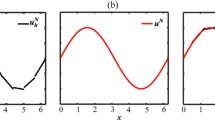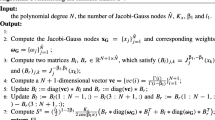Abstract
For two-dimensional (2D) time fractional diffusion equations, we construct a numerical method based on a local discontinuous Galerkin (LDG) method in space and a finite difference scheme in time. We investigate the numerical stability and convergence of the method for both rectangular and triangular meshes and show that the method is unconditionally stable. Numerical results indicate the effectiveness and accuracy of the method and confirm the analysis.




Similar content being viewed by others
References
Basu, T.S., Wang, H.: A fast second-order finite difference method for space-fractional diffusion equations. Int. J. Numer. Anal. Model. 9, 658–666 (2012)
Carella, A.R., Dorao, C.A.: Least-squares spectral method for the solution of a fractional advection–dispersion equation. J. Comput. Phys. 232, 33–45 (2013)
Cockburn, B., Dong, B.: An analysis of the minimal dissipation local discontinuous Galerkin method for convection–diffusion problems. J. Sci. Comput. 32, 233–262 (2007)
Cockburn, B., Kanschat, G., Perugia, I., Schotzau, D.: Superconvergence of the local discontinuous Galerkin method for elliptic problems on Cartesian grids. SIAM J. Numer. Anal. 39, 264–285 (2002)
Cockburn, B., Shu, C.W.: The local discontinuous Galerkin method for time-dependent convection–diffusion systems. SIAM J. Numer. Anal. 35, 2440–2463 (1998)
Cui, M.R.: Compact finite difference method for the fractional diffusion equation. J. Comput. Phys. 228, 7792–7804 (2009)
Deng, W.H., Hesthaven, J.S.: Local discontinuous Galerkin methods for fractional diffusion equations. Math. Model. Numer. Anal. 47, 1845–1864 (2013)
Deng, W.H., Hesthaven, J.S.: Local discontinuous Galerkin methods for fractional ordinary differential equations. BIT Numer. Math. 55, 967–985 (2015)
Ding, H.F., Li, C.P.: Mixed spline function method for reaction–subdiffusion equation. J. Comput. Phys. 242, 103–123 (2013)
Dong, B., Shu, C.W.: Analysis of a local discontinuous Galerkin method for linear time-dependent fourth-order problems. SIAM J. Numer. Anal. 47, 3240–3268 (2009)
Du, R., Cao, W.R., Sun, Z.Z.: A compact difference scheme for the fractional diffusion–wave equation. Appl. Math. Model. 34, 2998–3007 (2010)
Ervin, V.J., Heuer, N., Roop, J.P.: Numerical approximation of a time dependent, nonlinear, space-fractional diffusion equation. SIAM J. Numer. Anal. 45, 572–591 (2007)
Eshaghi, J., Kazem, S., Adibi, H.: The local discontinuous Galerkin method for 2D nonlinear time-fractional advection–diffusion equations. Eng. Comput. 35, 1317–1332 (2019). https://doi.org/10.1007/s00366-018-0665-8
Fix, G., Roop, J.: Least squares finite element solution of a fractional order two-point boundary value problem. Comput. Math. Appl. 48, 1017–1033 (2004)
Gao, G.H., Sun, Z.Z.: A compact finite difference scheme for the fractional sub-diffusion equations. J. Comput. Phys. 230, 586–595 (2011)
Gao, G.H., Sun, Z., Zhang, H.: A new fractional numerical differentiation formula to approximate the Caputo fractional derivative and its applications. J. Comput. Phys. 259, 33–50 (2014)
He, J.H., Wu, X.H.: Variational iteration method: new development and applications. Comput. Math. Appl. 54, 881–894 (2007)
Huang, C., An, N., Yu, X.: A fully discrete direct discontinuous Galerkin method for the fractional diffusion–wave equation. Appl. Anal. 97, 659–675 (2018)
Jiang, Y., Ma, J.: High-order finite element methods for time-fractional partial differential equations. J. Comput. Appl. Math. 235, 3285–3290 (2011)
Jin, B., Lazarov, R., Liu, Y., Zhou, Z.: The Galerkin finite element method for a multi-term time-fractional diffusion equation. J. Comput. Phys. 281, 825–843 (2015)
Karaa, S., Mustapha, K., Pani, Amiya K.: Finite volume element method for two-dimensional fractional subdiffusion problems. IMA J. Numer. Anal. 37, 945–964 (2017)
Kochubei, A., Luchko, Y. (eds.) Handbook of Fractional Calculus with Applications, vol. 1. Basic Theory. Walter de Gruyter GmbH, Berlin (2019)
Li, C.Z., Chen, Y.: Numerical approximation of nonlinear fractional differential equations with subdiffusion and superdiffusion. Comput. Math. Appl. 62, 855–875 (2011)
Li, X.J., Xu, C.J.: A space–time spectral method for the time fractional diffusion equation. SIAM J. Numer. Anal. 47, 2108–2131 (2009)
Li, C.P., Zeng, F.H.: The finite difference methods for fractional ordinary differential equations. Numer. Funct. Anal. Optim. 34, 149–179 (2013)
Lin, Y.M., Xu, C.J.: Finite difference/spectral approximations for the time-fractional diffusion equation. J. Comput. Phys. 225, 1533–1552 (2007)
Liu, Y., Shu, C.W., Zhang, M.: Superconvergence of energy-conserving discontinuous Galerkin methods for linear hyperbolic equations. Commun. Appl. Math. Comput. 1, 101–116 (2019)
Liu, F., Zhuang, P., Burrage, K.: Numerical methods and analysis for a class of fractional advection–dispersion models. Comput. Math. Appl. 64, 2990–3007 (2012)
Meerschaert, M.M., Tadjeran, C.: Finite difference approximations for fractional advection–dispersion. J. Comput. Appl. Math. 172, 65–77 (2004)
Metzler, R., Klafter, J.: The random walk’s guide to anomalous diffusion: a fractional dynamics approach. Phys. Rep. 339, 1–77 (2000)
Miller, K.S., Ross, B.: An Introduction to the Fractional Calculus and Fractional Differential Equations. Wiley, New York (1993)
Mokhtari, R., Mostajeran, F.: A high order formula to approximate the Caputo fractional derivative. Commun. Appl. Math. Comput. 2, 1–29 (2020)
Oldham, K., Spanier, J.: The Fractional Calculus: Theory and Applications of Differentiation and Integration of Arbitray Order. Academic Press, New York (1974)
Podlubny, I., Chechkin, A., Skovranek, T., Chen, Y.Q., Jara, B.M.V.: Matrix approach to discrete fractional calculus II: partial fractional differential equations. J. Comput. Phys. 228, 3137–3153 (2009)
Qiu, L., Deng, W., Hesthaven, J.S.: Nodal discontinuous Galerkin methods for fractional diffusion equations on \(2{\text{D}}\) domain with triangular meshes. J. Comput. Phys. 298, 678–694 (2015)
Roop, J.P.: Computational aspects of FEM approximation of fractional advection dispersion equations on bounded domains in \({\mathbb{R}}^2\). J. Comput. Appl. Math. 193, 243–268 (2006)
Wang, H., Zhang, Q., Wang, S., Shu, C.W.: Local discontinuous Galerkin methods with explicit-implicit-null time discretizations for solving nonlinear diffusion problems. Sci. China Math. 63(1), 183–204 (2020). https://doi.org/10.1007/s11425-018-9524-x
Wang, H., Zhang, Q., Shu, C.W.: Third order implicit-explicit Runge–Kutta local discontinuous Galerkin methods with suitable boundary treatment for convection–diffusion problems with Dirichlet boundary conditions. J. Comput. Appl. Math. 342, 164–179 (2018)
Xu, Q., Zheng, Z.: Discontinuous Galerkin method for time fractional diffusion equation. J. Inf. Comput. Sci. 11, 3253–3264 (2013)
Yang, Q.Q., Turner, I., Liu, F., Ilic, M.: Novel numerical methods for solving the time space fractional diffusion equation in two dimensions. SIAM J. Sci. Comput. 33, 1159–1180 (2011)
Yeganeh, S., Mokhtari, R., Fouladi, S.: Using an LDG method for solving an inverse source problem of the time-fractional diffusion equation. Iran. J. Numer. Anal. Optim. 7, 115–135 (2017)
Yeganeh, S., Mokhtari, R., Hesthaven, J.S.: Space-dependent source determination in a time-fractional diffusion equation using a local discontinuous Galerkin method. BIT Numer. Math. 57, 685–707 (2017)
Zhang, X., Tang, B., He, Y.: Homotopy analysis method for higher-order fractional integro-differential equations. Comput. Math. Appl. 62, 3194–3203 (2011)
Zhao, Y., Chen, P., Bu, W., Liu, X., Tang, Y.: Two mixed finite element methods for time-fractional diffusion equations. J. Sci. Comput. 70, 407–428 (2017)
Zhuang, P., Liu, F.: Finite difference approximation for two-dimensional time fractional diffusion equation. J. Algorithm Comput. Tech. 1, 1–15 (2007)
Author information
Authors and Affiliations
Corresponding author
Ethics declarations
Conflict of interest
There is no conflict of interest.
Appendix A
Appendix A
Another approximations to the time-fractional derivative (2) are L1-2 and L1-2-3 formulae [16, 32] which can be obtained by using quadratic and cubic interpolation formulae, respectively. The order of convergence with respect to the time variable for L1, L1-2, and L1-2-3 formulas are \(2-\alpha \), \(3-\alpha \), and \(4-\alpha \), respectively. We follow here just L1-2 formula which is
where \(c_0=1\) for \(n=1\); and for \(n\geq 2\),
where
and
and \(\gamma ^n\) is the truncation error with the estimate
Then, we can define a fully discrete LDG scheme as follows: find \((u_{h}, {\varvec{q}}_{h})\), such that for all test functions \((v, {\varvec{v}})\in V_{h}^{k}\times {\varvec{V}}_{h}^{k}\),
where \(\beta =(\Delta t)^\alpha {\varvec{\Gamma }}(2-\alpha )\). In order to examine the convergence of the scheme (A1), we express the following result.
Theorem A1
Let \(u(\cdot ,t_n)\)be the exact solution of problem (1) with homogeneous Dirichlet boundary conditions, which is sufficiently smooth with bounded derivatives, and \(u_h^n\)be the numerical solution of the LDG scheme (23). There holds the following error estimate on Cartesian meshes:
and on triangular meshes
where C is a constant depending on \(T, \alpha, \)and u.
Proof
It is more or less similar to the proof of Theorem 2.
Rights and permissions
About this article
Cite this article
Yeganeh, S., Mokhtari, R. & Hesthaven, J.S. A Local Discontinuous Galerkin Method for Two-Dimensional Time Fractional Diffusion Equations. Commun. Appl. Math. Comput. 2, 689–709 (2020). https://doi.org/10.1007/s42967-020-00065-7
Received:
Revised:
Accepted:
Published:
Issue Date:
DOI: https://doi.org/10.1007/s42967-020-00065-7
Keywords
- Two-dimensional (2D) time fractional diffusion equation
- Local discontinuous Galerkin method (LDG)
- Numerical stability
- Convergence analysis




